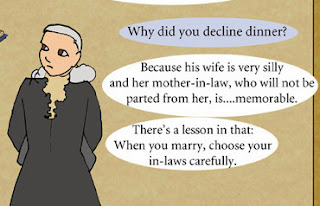Variations on the basic fish trap can be found worldwide. They were outlawed in England a few centuries before, possibly because they blocked river traffic. Not that the law applies here. I found the idea interesting enough to tuck into this chapter, but that's as much as I have to say about it.
But I have something else to talk about today! I think I have mentioned how much I love the unique antiques that come my way at work. In a midcentury canasta box I found 4 antique dice. Canasta is a card game, I think, so the dice didn't belong to it; and they were far too unusual to belong to the 50s, anyway. One was wood, hand carved, painted black, with hand-painted pips. Three were bone, unmistakably, had considerable wear, and were nonstandard sizes. One of those had a faint mark on it: G.R and a crown.
Google helpfully told me that G.R. stands for George Rex (King George) and that the hallmark meant that it was made in England after the Stamp Act of 1765. I didn't know which King George, but George IV died in 1830, and after that it would have been stamped V.R. for Victoria Regina.
So far, 1765-1830 is a pretty awesome age for a bone die, and makes it interesting in its own right. But at the risk of boring you, I'll relate what else I know and how those dice tie in to American history.
Most of the other dice with the G.R. mark were tagged Revolutionary War, on the reasoning that British soldiers might have brought them to the U.S. to dice with. I wasn't terribly satisfied with that reasoning; sellers just trying to get hits and make a buck, I think.
I'll tell you what, though. In the 1760s, the British Empire was overextended, underfunded, and fighting on too many fronts. The Stamp Act of 1765 was their attempt to raise money by taxing the crap out of the colonies, including taxes on stationary, newspapers, playing cards, and dice. The American colonies felt they were taxed unfairly and the building resentment eventually led to the Revolutionary War. That's an explanation I feel more comfortable with.
On an only slightly related subject, in 1795 the British government again tried to raise money by levying a tax on hair powder. Anyone who was anyone wore a wig, and even many servants, and so hair powder was a necessity- or so they thought. Instead, in an ironic twist, wigs went out of fashion overnight.
I've rambled long enough! Good night, Happy Holidays, and I'll write again soon.
But I have something else to talk about today! I think I have mentioned how much I love the unique antiques that come my way at work. In a midcentury canasta box I found 4 antique dice. Canasta is a card game, I think, so the dice didn't belong to it; and they were far too unusual to belong to the 50s, anyway. One was wood, hand carved, painted black, with hand-painted pips. Three were bone, unmistakably, had considerable wear, and were nonstandard sizes. One of those had a faint mark on it: G.R and a crown.
Google helpfully told me that G.R. stands for George Rex (King George) and that the hallmark meant that it was made in England after the Stamp Act of 1765. I didn't know which King George, but George IV died in 1830, and after that it would have been stamped V.R. for Victoria Regina.
So far, 1765-1830 is a pretty awesome age for a bone die, and makes it interesting in its own right. But at the risk of boring you, I'll relate what else I know and how those dice tie in to American history.
Most of the other dice with the G.R. mark were tagged Revolutionary War, on the reasoning that British soldiers might have brought them to the U.S. to dice with. I wasn't terribly satisfied with that reasoning; sellers just trying to get hits and make a buck, I think.
I'll tell you what, though. In the 1760s, the British Empire was overextended, underfunded, and fighting on too many fronts. The Stamp Act of 1765 was their attempt to raise money by taxing the crap out of the colonies, including taxes on stationary, newspapers, playing cards, and dice. The American colonies felt they were taxed unfairly and the building resentment eventually led to the Revolutionary War. That's an explanation I feel more comfortable with.
On an only slightly related subject, in 1795 the British government again tried to raise money by levying a tax on hair powder. Anyone who was anyone wore a wig, and even many servants, and so hair powder was a necessity- or so they thought. Instead, in an ironic twist, wigs went out of fashion overnight.
I've rambled long enough! Good night, Happy Holidays, and I'll write again soon.







